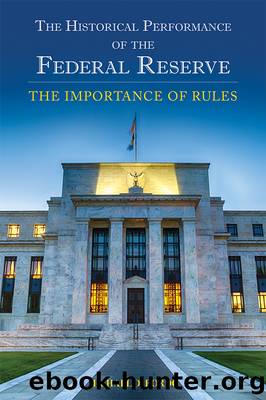The Historical Performance of the Federal Reserve by Bordo Michael D.;

Author:Bordo, Michael D.;
Language: eng
Format: epub
Tags: Federal Reserve, central bank, Great Recession, Taylor Rule, inflation, money, credit crisis, banking, monetary policy, interest rates
Publisher: Independent Publishers Group
Published: 2019-06-02T00:00:00+00:00
Another approach is to relate the amplitude not to changes over the NBER contraction, but over the cycle phases for money, credit and stock prices that the HardingâPagan algorithm identifies. Claessens, Kose and Terrones compare the depth of recessions with large and small credit crunches. With fewer recessions, we take a more multivariate approach, and regress recession amplitude against cycle amplitude for the risk spread, the money measure (either quantity or short-term interest rate) and the stock price. For example, if a recession begins (e.g., a peak occurs) when the money supply is in a contraction phase, we associate the amplitude of the NBER recession with the amplitude of that monetary contraction (which will rarely have the same turning points or duration). Tables 7.10 and 7.11 report the results for the nineteenth and twentieth centuries. The results are broadly similar to those in the NBER focused regression of Tables 7.9 and 7.10, but there are some differences. The coefficient on the risk spread shows up as positive in the twentieth century. Few coefficients are significant in the twentieth century, except when the risk-spreadâmoneyâgrowth interaction is included. TFP growth tends to be negatively associated with recessions.
Download
This site does not store any files on its server. We only index and link to content provided by other sites. Please contact the content providers to delete copyright contents if any and email us, we'll remove relevant links or contents immediately.
Zero to IPO: Over $1 Trillion of Actionable Advice from the World's Most Successful Entrepreneurs by Frederic Kerrest(4064)
Machine Learning at Scale with H2O by Gregory Keys | David Whiting(3640)
Harry Potter and the Goblet Of Fire by J.K. Rowling(3612)
Never by Ken Follett(3533)
Ogilvy on Advertising by David Ogilvy(3338)
Shadow of Night by Deborah Harkness(3177)
The Man Who Died Twice by Richard Osman(2811)
Book of Life by Deborah Harkness(2721)
My Brilliant Friend by Elena Ferrante(2704)
How Proust Can Change Your Life by Alain De Botton(2615)
0041152001443424520 .pdf by Unknown(2599)
Will by Will Smith(2581)
The Tipping Point by Malcolm Gladwell(2562)
How to Pay Zero Taxes, 2018 by Jeff A. Schnepper(2503)
Purple Hibiscus by Chimamanda Ngozi Adichie(2493)
Hooked: A Dark, Contemporary Romance (Never After Series) by Emily McIntire(2423)
Rationality by Steven Pinker(2150)
Borders by unknow(2119)
Daughter of Smoke and Bone by Laini Taylor(2083)
